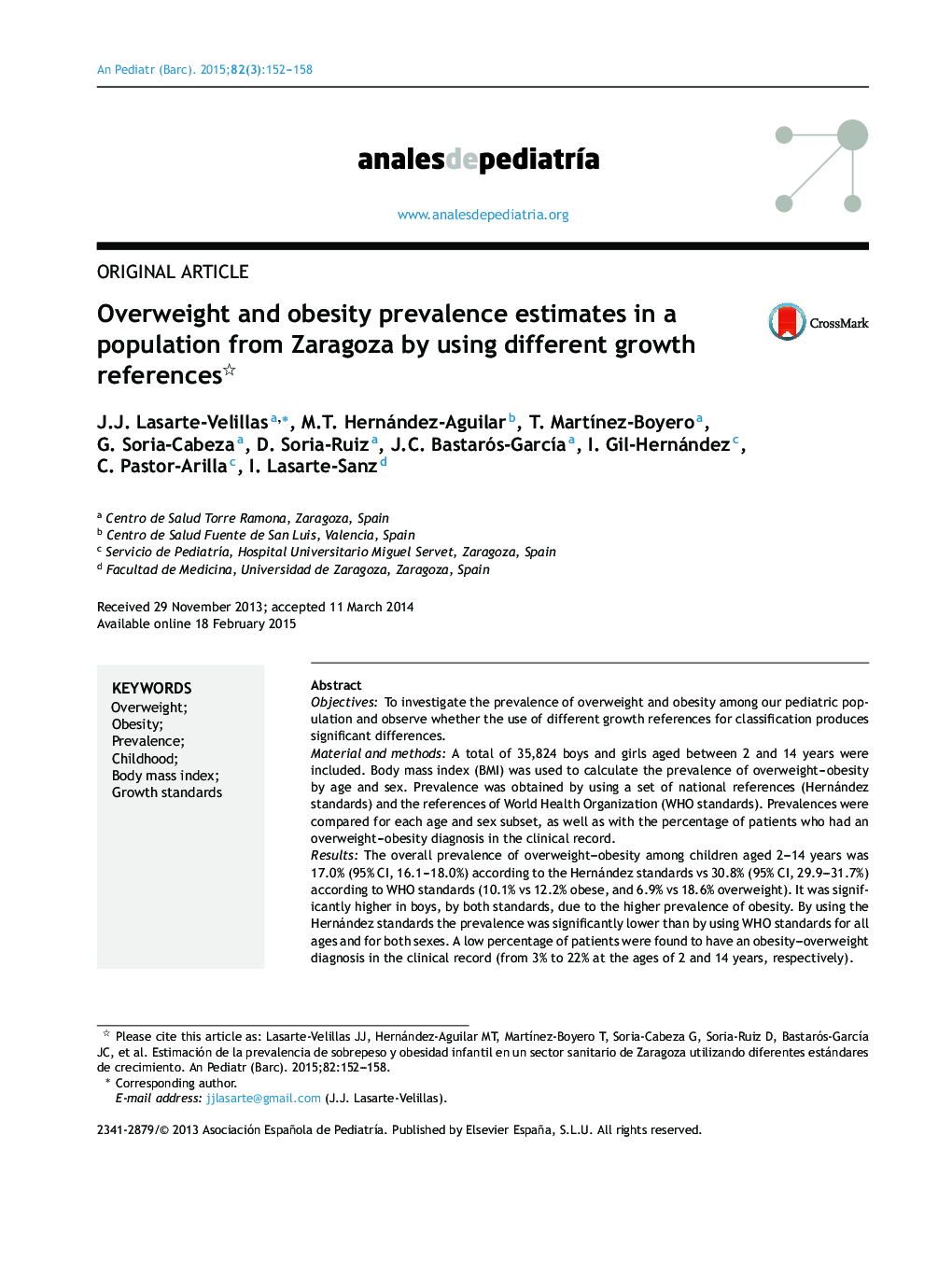| کد مقاله | کد نشریه | سال انتشار | مقاله انگلیسی | نسخه تمام متن |
|---|---|---|---|---|
| 4145184 | 1272592 | 2015 | 7 صفحه PDF | دانلود رایگان |
ObjectivesTo investigate the prevalence of overweight and obesity among our pediatric population and observe whether the use of different growth references for classification produces significant differences.Material and methodsA total of 35,824 boys and girls aged between 2 and 14 years were included. Body mass index (BMI) was used to calculate the prevalence of overweight–obesity by age and sex. Prevalence was obtained by using a set of national references (Hernández standards) and the references of World Health Organization (WHO standards). Prevalences were compared for each age and sex subset, as well as with the percentage of patients who had an overweight–obesity diagnosis in the clinical record.ResultsThe overall prevalence of overweight–obesity among children aged 2–14 years was 17.0% (95% CI, 16.1–18.0%) according to the Hernández standards vs 30.8% (95% CI, 29.9–31.7%) according to WHO standards (10.1% vs 12.2% obese, and 6.9% vs 18.6% overweight). It was significantly higher in boys, by both standards, due to the higher prevalence of obesity. By using the Hernández standards the prevalence was significantly lower than by using WHO standards for all ages and for both sexes. A low percentage of patients were found to have an obesity–overweight diagnosis in the clinical record (from 3% to 22% at the ages of 2 and 14 years, respectively).ConclusionsThe prevalence of overweight–obesity in our population is high, especially among boys. Using Hernández standards leads to an under-estimation of the problem, especially because it detects less overweight patients; thus, we recommend using the WHO standards in our daily practice. The low number of overweight–obesity diagnoses in the clinical records might reflect that there is little awareness of the problem by the professionals.
ResumenObjetivosConocer la prevalencia de sobrepeso y obesidad en nuestro medio y objetivar si hay diferencias significativas al utilizar los estándares de crecimiento de Hernández o los de la Organización Mundial de la Salud (OMS).Material y métodosel 35824 niñas y niños de 2 a 14 años. Para determinar las prevalencias, mediante ambos estándares (Hernández y OMS), se utilizó el índice de masa corporal. Se compararon y se analizaron las diferencias de prevalencias por edad y sexo y con el porcentaje de pacientes que tenían registrado algún diagnóstico de obesidad-sobrepeso en la historia clínica.ResultadosLa prevalencia global de sobrepeso-obesidad de 2 a 14 años fue del 17,0% (IC del 95%, 16,1%-18,0%) según estándares de Hernández y del 30,8% (IC del 95%, 29,9%-31,7%) según estándares OMS (obesidad 10,1% y 12,2%, sobrepeso 6,9% y 18,6%, respectivamente). Fue significativamente mayor en varones, según ambos estándares, debido a la mayor prevalencia de obesidad. Con los estándares de Hernández se obtuvieron prevalencias significativamente menores que con los de OMS, en todas las edades y en ambos sexos. Detectamos un bajo porcentaje de registro del diagnóstico (del 3 al 22% a los 2 y 14 años, respectivamente).ConclusionesEn nuestra población, la prevalencia de sobrepeso-obesidad es alta y es mayor en varones. La utilización de los estándares de Hernández infravalora la sobrecarga ponderal, sobre todo porque detecta menos pacientes con sobrepeso, por lo que creemos que sería preferible incorporar los estándares de OMS de forma sistemática a la práctica diaria. El escaso registro del diagnóstico de sobrepeso-obesidad en la historia clínica podría reflejar una escasa percepción del problema por parte de los profesionales.
Journal: Anales de Pediatría (English Edition) - Volume 82, Issue 3, March 2015, Pages 152–158
